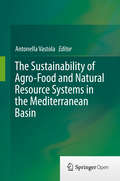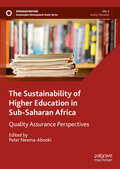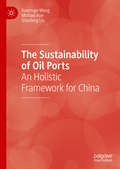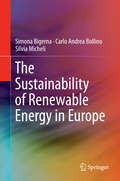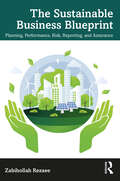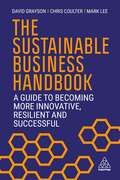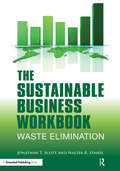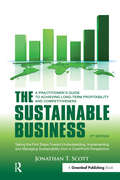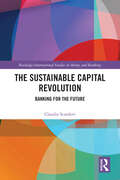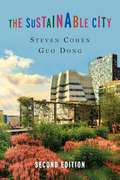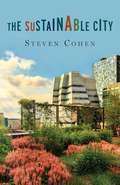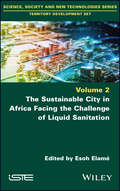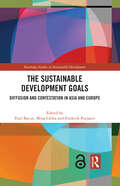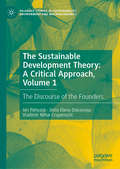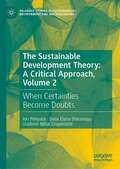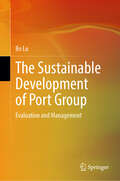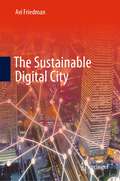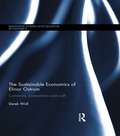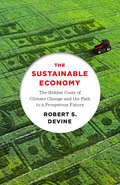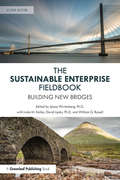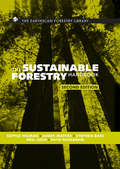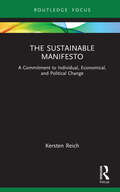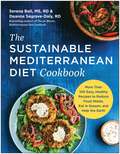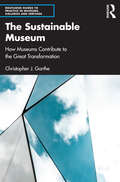- Table View
- List View
The Sustainability of Agro-Food and Natural Resource Systems in the Mediterranean Basin
by Antonella VastolaThis book is focused on the challenges to implement sustainability in diverse contexts such as agribusiness, natural resource systems and new technologies. The experiences made by the researchers of the School of Agricultural, Forestry, Food and Environmental Science (SAFE) of the University of Basilicata offer a wide and multidisciplinary approach to the identification and testing of different solutions tailored to the economic, social and environmental characteristics of the region and the surrounding areas. Basilicata's productive system is mainly based on activities related to the agricultural sector and exploitation of natural resources but it has seen, in recent years, an industrial development driven by the discovery of oil fields. SAFE research took up the challenge posed by market competition to create value through the sustainable use of renewable and non-renewable resources of the territory. Moreover, due to its unique geographical position in the middle of the Mediterranean basin, Basilicata is an excellent "open sky" laboratory for testing sustainable solutions adaptable to other Mediterranean areas. This collection of multidisciplinary case studies and research experiences from SAFE researchers and their scientific partners is a stimulating contribution to the debate on the development of sustainable techniques, methods and applications for the Mediterranean regions.
The Sustainability of Higher Education in Sub-Saharan Africa: Quality Assurance Perspectives (Sustainable Development Goals Series)
by Peter Neema-AbookiThis book delves into the role of higher education as a means of sustainable development in Sub-Saharan Africa. Contributions from across the region examine the strategies and technological advances available to enable students to deal with an uncertain future and are organised under two key themes: Curriculum and Teaching and Higher Education and Innovations. The volume brings together theoretical and practical perspectives, relating them to international benchmarks while maintaining the specificities of the African context. It will be of interest to students and scholars as well as practitioners whose work interrogates higher education, quality assurance, and sustainable development goals.
The Sustainability of Oil Ports: An Holistic Framework for China
by Michael Roe Shaofeng Liu Xuemuge WangThis book provides an original analysis of the problems of ensuring that oil ports are sustainable in the broadest sense of the concept including environmental, social, technical and resource aspects. Taking China as its frame for analysis, chosen because of the authors’ expertise and because it is the largest oil import country in the world, much of it by ship, it presents a detailed investigation of the issues that make up a sustainable port profile, using a variety of established statistical and operational techniques These are examined before an holistic model is derived. Recommendations are provided for future application both in China and elsewhere and also a range of ways suggested for how the framework could be adapted to other types of ports and locations.
The Sustainability of Renewable Energy in Europe
by Simona Bigerna Carlo Andrea Bollino Silvia MicheliThis book demonstrates that the much-needed global shift in energy production and use must happen at a territorial level in order to be truly successful and sustainable. This book enables regional implementation efforts by connecting broad EU environmental policies with plans for action at the territorial level, analysing efficient resource allocation and cost effectiveness to achieve national objectives. Each EU Member State is considered in depth, in order to identify the opportunities and challenges of this regional approach. The regional dimension of the authors' analysis refers to the territorial level NUTS 1 (Nomenclature of Territorial Units for Statistics) that, starting from the administrative borders of the EU countries, divides the territory into 97 regions on the basis of major socio-economic characteristics. Because the model of the EU "green economy" is characterized typically by top-down interventions that focus exclusively on the resource productivity and investment business, its practical implementation can be de-railed. This book provides the pivotal missing piece- the detailed territorial comparative analysis necessary to obtain an optimal energy mix of renewable energy sources (RES), energy conservation and energy efficiency characteristics of each specific local context.
The Sustainable Asian House
by Masano Kawana Paul McgillickToday's byword is sustainability, and in few arenas is that more evident than in architecture. The Sustainable Asian House celebrates the new architectural vocabulary of environmental, social, and cultural sustainability as it is now emerging in Southeast Asia, specifically Thailand, Malaysia, Singapore, Indonesia, and the Philippines.The houses in this book are an exciting representation of the region's reinterpretation of tropical architecture and its growing interest in traditional materials and craftsmanship. There is a new emphasis on fresh air, natural light, and spatial variety. Designers are considering issues such as orientation to the sun and prevailing winds to reduce energy consumption and carbon footprint. The twenty-seven houses are featured in this fascinating and stunningly photographed study.
The Sustainable Business Blueprint: Planning, Performance, Risk, Reporting, and Assurance
by Zabihollah RezaeeUnderstanding how to build and manage a sustainability business plan has become a business imperative as investors demand, regulators require, and stakeholders increasingly expect companies to report their financial economic sustainability performance (ESP) and non-financial environmental, social, and governance (ESG) sustainability information. This book provides both the rationale for and key practical steps in how to approach business sustainability factors of planning, performance, risk, reporting, and assurance.This comprehensive book covers all the areas that a business would need to embed, articulate, and execute a strategy of profit-with-purpose in promoting shared value creation for all stakeholders. It addresses drivers, sources, and international guidelines (GRI, IIRC, SASB, FASB, PCAOB, IAASB, ISSB) for prioritising business sustainability factors, and establishing the link between ESG performance and financial performance. It presents key performance indicators (KPIs) of ESP and ESG dimensions of sustainability performance. It also provides templates for performance, risk, and disclosure; presenting cases and examples of why to disclose ESG performance, what to disclose, and where and how to disclose ESG performance information.For businesses wanting a detailed understanding of how to deliver on these important areas, including boards of directors, senior management, financial officers, internal auditors, external auditors, legal counsel, investors, and regulators, this book is an invaluable resource.
The Sustainable Business Handbook: A Guide to Becoming More Innovative, Resilient and Successful
by David Grayson Chris Coulter Mark LeeThe case for business sustainability has already been made; organizations can no longer ignore the issue when climate change affects supply chains and customer expectations require them to take action. It has also been proven that businesses operating sustainably drive innovation, build brand value and are more profitable.It is therefore time to shift the conversation from the 'why' of business sustainability to the 'how'. The Sustainable Business Handbook is a practical 'how-to' guide which aims to demystify jargon and provide practical tools and tips for busy managers. Rather than preaching the importance of sustainability, it cuts straight to how businesses can become more resilient and successful in the long term by becoming more sustainable.This indispensable book is based around twenty top tips for transforming your business and is interspersed with a range of individual profiles and case studies of organizations successfully embracing sustainability. With guidance on defining your organizational purpose, engaging stakeholders and creating the right culture, The Sustainable Business Handbook outlines how to shift Corporate Responsibility from being a bolt-on to business operations to being a source of innovation and new business, as well as societal good.
The Sustainable Business Workbook: A Practitioner's Guide to Achieving Long-Term Profitability and Competitiveness
by Jonathan T. Scott Walter R. StahelWhether you are undertaking the exercises for your own purposes or with the intent of completing a certification course in sustainable development, this workbook will be of help. The companion text for this publication is The Sustainable Business: A Practitioner's Guide to Achieving Long-Term Profitability and Competitiveness (2nd edition). Read the companion text thoroughly before beginning this workbook. Follow a step-by-step approach using the 7-P Roadmap to Sustainability Model and work your way through the seven sections that comprise the companion text (Preparation, Processes, Preservation, People, Place, Product and Production). This workbook focuses on Waste Elimination. A forthcoming workbook will focus on Resource Extension. This workbook will increase your knowledge and understanding, subject-specific skills and personal and transferable skills.
The Sustainable Business: A Practitioner's Guide to Achieving Long-Term Profitability and Competitiveness
by Jonathan T. ScottThis is the 2nd edition of The Sustainable Business (2010), winner of The President's Award for Excellence in a Published Body of Work at Kozminski University, Poland. Recommended for managers, employees, teachers and students, this readable and informative guide explains the importance of waste minimization as a first step toward sustainability. Within its pages, the breadth and depth of long-term profitable business practices are explored with an emphasis on optimizing resources (including labour and markets) and maximizing purchases and investments while eliminating the costs of non-product (waste), unemployment, short-term thinking and environmental degradation. As proof of its potency, The Sustainable Business has already been disseminated to over 1.3 million people around the world and the first edition is available in four different languages. The bottom line: if you're looking to gain insight on the future of business, this is it!
The Sustainable Capital Revolution: Banking for the Future (Routledge International Studies in Money and Banking)
by Claudio ScardoviModern capitalism has focused on profit maximization at the expense of non-renewable natural resources. This has led to wealth polarization – that is, social unsustainability – and climate change – that is, environmental unsustainability. Value migration has occurred between the ultra-rich and the “remaining 99%” and across generations, with increased longevity and a demographic winter expected to contribute even more. All this has led us on a collision course with several existential threats.This book explains that a quick and decisive sustainability conversion is necessary, requiring significant investment and careful management of trade-offs – such as those between environmental and financial risk. The author argues that a “sustainable capital” approach would account for all scarce resources used in any investment decision and adjust its risk-based pricing. It would redefine the foundations of modern finance and economics, overcoming the limits and negative implications of well-known metrics and supporting the funding required for green conversion and reduced wealth polarization. Ultimately, a “sustainable capital” approach could inform long-term sustainability transformation strategies and be used to develop a first set of pragmatic, market-based initiatives, involving non-bank funding and an operating partner approach, to accelerate a “wealth to wellbeing” and a “brown to green” transformation and the workout of the (otherwise stranded) socially and environmentally non-performing assets – securing the survival and evolution of our eco-system.This book is aimed at those involved in the world of finance, investment management, and banking, with a specific focus on sustainable finance and green transformation. It will also be of relevance to readers interested in economic policies and the broader topic of equality, social sustainability, and wealth creation.
The Sustainable City
by Steven Cohen Dong GuoLiving sustainably is not just about preserving the wilderness or keeping nature pristine. The transition to a green economy depends on cities. Economic, technological, and cultural forces are moving people out of rural areas and into urban areas. If we are to avert climate catastrophe, we will need our cities to coexist with nature without destroying it. Urbanization holds the key to long-term sustainability, reducing per capita environmental impacts while improving economic prosperity and social inclusion for current and future generations.The Sustainable City provides a broad and engaging overview of the urban systems of the twenty-first century. It approaches urban sustainability from the perspectives of behavioral change, organizational management, and public policy, looking at case studies of existing legislation, programs, and public-private partnerships that strive to align modern urban life and sustainability. The book synthesizes the disparate strands of sustainable city planning in an approachable and applicable guide that highlights how these issues touch our lives on a daily basis, including the transportation we take, the public health systems that protect us, where our energy comes from, and what becomes of our food waste.This second edition of The Sustainable City dives deeper into the financing of sustainable infrastructure and initiatives and puts additional emphasis on the roles that individual citizens and varied stakeholders can play. It also reviews current trends in urban inequality and discusses whether a model of sustainability that embraces a multidimensional approach to development and a multistakeholder approach to decision making can foster social inclusion. It features many more examples and new international case studies spanning the globe.
The Sustainable City
by Steven CohenLiving sustainably is not just about preserving the wilderness or keeping nature pristine. The transition to a green economy depends on cities. For the first time in human history, the majority of the people on the planet live in urban areas. If we are to avert climate catastrophe, we will need our cities to coexist with nature without destroying it. Many places are already investing in the infrastructure of the future—including renewable energy, energy efficiency, mass and personal transit, and advanced sewage and waste management—but the modern city still has a long way to go.In The Sustainable City, Steven Cohen provides a broad and engaging overview of the urban systems of the twenty-first century, surveying policies and projects already under way in cities around the world and pointing to more ways progress can be made. Cohen discusses the sustainable city from an organizational-management and public-policy perspective that emphasizes the local level, looking at case studies of existing legislation, programs, and public-private partnerships that strive to align modern urban life and sustainability. From waste management in Beijing to energy infrastructure in Africa to public space in Washington, D.C., there are concrete examples of what we can do right now. Cohen synthesizes the disparate strands of sustainable city planning in an approachable and applicable guide that highlights how these issues touch our lives on a daily basis, whether the transportation we take, where our energy comes from, or what becomes of our food waste. Providing recommendations and insights with immediacy and relevance, this book has invaluable lessons for anyone seeking to link public policy to promoting a sustainable lifestyle.
The Sustainable City in Africa Facing the Challenge of Liquid Sanitation
by Esoh ElaméThis book questions the role of liquid sanitation in the development of cities in Africa. The absence of sewerage networks and treatment plants in African cities already submerged by rapid and anarchic urbanization is a major problem. To meet this challenge, it is urgent to rethink urban water governance and impose and enforce sustainable urban planning standards. In other words, sanitation issues must now be placed at the heart of urban planning.
The Sustainable Development Goals: Diffusion and Contestation in Asia and Europe (Routledge Studies in Sustainable Development)
by Paul Bacon Frederik Ponjaert Mina ChibaThere have been significant efforts to implement the Sustainable Development Goals (SDGs) at multiple levels of governance across all regions of the world. However, the manner in which the global governance norms underlying the SDGs are actually being diffused is under-researched and not well understood. This book considers the promotion of the SDGs through the lens of norm diffusion theory, with a focus on three SDG policy areas; health, education and decent work. A distinctive feature of the book is that it offers multiple original case studies of SDG norm diffusion involving Asian and European actors. A unique feature is that the case studies in the book identify relevant SDG norm senders and norm receivers, and examine the relationship between them. The book also challenges the assumption that the SDGs themselves are static and unchanging, and reveals how SDG norms are dynamic and can be reformulated as a result of contestation between norm senders and norm receivers. As well as introducing a diverse and original set of case studies, the book therefore allows readers to deepen their understandings of the policy diffusion mechanisms by which SDGs are diffused, and grasp the patterns of success and failure in the implementation of these policies.
The Sustainable Development Theory: The Discourse of the Founders (Palgrave Studies in Sustainability, Environment and Macroeconomics)
by Delia Elena Diaconaşu Vladimir Mihai Crupenschi Ion PohoațăThis book argues that the theory of sustainable development lost some of its rigor because of two main reasons. The first manifests itself as an inflation of concepts that hampers the correct understanding of sustainability’s essence. The second one consists of a departure from the traditional scientific sources of the classicists and, in part, neoclassicists. Exploiting relevant areas of their works, the authors outline the theoretical framework necessary to promote a healthy version of sustainability. Of utmost interest prove to be areas such as: the formation process of natural prices and natural rate of interest; placing growth before employment and placing production before distribution, consumption, and social justice. The main idea of the book consists of a call for breaking away from the impure forms of the theory of sustainable development and its reconstruction through the reconciliation with the laws of healthy growth as they are highlighted in the works of the founders. The authors make the case for an approach to sustainable development that is holistic, macroeconomic, and institutionalist, where social, ecological, and economic components are reconciled. This work presents a fresh perspective in the context of current works on sustainability, serving as an accessible research resource and public policy decision guide.
The Sustainable Development Theory: When Certainties Become Doubts (Palgrave Studies in Sustainability, Environment and Macroeconomics)
by Ion Pohoaţă Delia Elena Diaconaşu Vladimir Mihai CrupenschiThis book explores the present conflictual relationship between the economy, the environment, and society. The current mainstream economic model is analysed from the perspective of the founding economists to review its suitability to tackle issues of sustainable development. The problems of redistribution and social justice are debated at length; alongside those concerning the giant state, degrowth, and a vision of sustainability that is founded on the idea of a self-regulating free market economy. Business cycle sustainability, anti-crisis therapy, technological unemployment, the natural rate of interest, and the Bruntland matrix are also examined.This book aims to present a holistic approach to sustainable development where social, ecological, and economic components are balanced. It will be relevant to students and researchers interested in this topic.
The Sustainable Development of Port Group: Evaluation and Management
by Bo LuThis book primarily focuses on the coordinated development of port groups and the environment. It extensively reviews relevant literature and draw on existing theoretical research achievements to analyze the mechanisms and influencing factors behind the formation of green, ecological, or energy-saving ports. It employs attribution decomposition analysis and LMDI decomposition methods to identify driving forces and factors for low-carbon ports. Furthermore, with the goal of minimizing the comprehensive cost of low-carbon port investment and considering constraints such as the upper limit of low-carbon investment in ports, the book utilizes tools such as stochastic processes and optimization decision theory to establish an optimization model for carbon emission reduction investment in low-carbon ports, aiming to find the best investment solution. Throughout the process, the book employs a combination of quantitative and qualitative analysis methods and provides corresponding recommendations and suggestions from an industry and port perspective through comparative analysis and case studies.
The Sustainable Digital City
by Avi FriedmanThis book explores the rise of technology-centered urban planning and the diffusion of these practices around the world. Seven axes of urban planning have been selected to highlight how data and technology currently work and how these systems can be improved going forward. Each aspect is explored in its own chapter that combines narrative description, illustrations, and case studies to show how technology currently shapes our cities and how this may impact the urban environments. Topics include infrastructure, mobility, energy use and distribution, work, public health, and knowledge transfer among others. The book also demonstrates how these aspects are tied to and affect the four pillars of sustainability: environment, society, economy, and culture.
The Sustainable Economics of Elinor Ostrom: Commons, contestation and craft (Routledge Studies in Ecological Economics #33)
by Derek WallElinor Ostrom’s Nobel Prize-winning work on common pool property rights has implications for some of the most pressing sustainability issues of the twenty-first century — from tackling climate change to maintaining cyberspace. In this book, Derek Wall critically examines Ostrom’s work, while also exploring the following questions: is it possible to combine insights rooted in methodological individualism with a theory that stresses collectivist solutions? Is Ostrom’s emphasis on largely local solutions to climate change relevant to a crisis propelled by global factors? This volume situates her ideas in terms of the constitutional analysis of her partner Vincent Ostrom and wider institutional economics. It outlines her key concerns, including a radical research methodology, commitment to indigenous people and the concept of social-ecological systems. Ostrom is recognised for producing a body of work which demonstrates how people can construct rules that allow them to exploit the environment in an ecologically sustainable way, without the need for governmental regulation, and this book argues that in a world where ecological realities increasingly threaten material prosperity, such scholarship provides a way of thinking about how humanity can create truly sustainable development. Given the inter-disciplinary nature of Ostrom’s work, this book will be relevant to those working in the areas of environmental economics, political economy, political science and ecology.
The Sustainable Economy: The Hidden Costs of Climate Change and the Path to a Prosperous Future
by Robert DevineAn original, engaging guide to creating a sustainable economy that will combat global warming while also improving our quality of life.Pick an environmental issue. Maybe air pollution, toxic waste, or deforestation. These all seem like solid choices, but none of these is actually an environmental problem--at least, not at its heart. Deep down, they are economic problems. Nearly all the issues we classify as environmental stem from defects in the DNA of America's current market system. This is emphatically true of our greatest environmental threat: global warming.With a focus on climate change, journalist and author Robert S. Devine reveals the fundamental flaws in the economy that enable environmental degradation. The Sustainable Economy is a book about economics, but it skips the equations and eases through the jargon, opting instead for compelling stories and surprising humor. Readers will encounter high-tech narwhals, struggling coal workers, orbiting giant mirrors, the kids who are suing the U.S. government over climate policy, and vanishing Alaskan towns.The Sustainable Economy looks at many of the most pressing climate issues, such as melting ice caps and farm-killing droughts, but by viewing them through the revealing lens of economics, the book delivers a fresh perspective. Devine shows how the basic mechanisms of supply and demand fail when it comes to global warming and the environment. Fortunately, he also lays out a path to an improved economy that can boost our well-being while also fostering a healthy environment. Most importantly, The Sustainable Economy shows how we can overcome the political and personal obstacles blocking progress toward a sustainable, just, and prosperous economy.
The Sustainable Enterprise Fieldbook: Building New Bridges
by David Lipsky Jeana Wirtenberg Linda M. Kelley William G. RussellWith deep thought and inspiring examples, this updated book engages readers by increasing their understanding and awareness of what sustainability means conceptually, practically, personally, and professionally. It provides readers with the tools and techniques to improve the social, environmental, and economic performance of their organizations in both the short and long term. Since sustainability is not achieved in a siloed environment, everyone has a critical role to play on this journey. The Sustainable Enterprise Fieldbook engages today’s managers and leaders of organizations, in both the private sector and civil society, who are being challenged as never before to find ways to play a proactive role in understanding and addressing the risks and opportunities of sustainability. It teaches them how to apply systems thinking to turn our most intractable problems into exciting business opportunities, and offers ground breaking frameworks in new chapters on globalization, strategy, metrics, and sustainability models for collaboration, technology, and community. That is why this book is structured to be a fieldbook to provide practitioners the Activities, Cases, and Tools that they can use to help move their enterprise through progressively higher performing stages of sustainability. Readers will also gain access to the innovative Living Fieldbook: an online community forum filled with supporting materials.
The Sustainable Forestry Handbook: A Practical Guide for Tropical Forest Managers on Implementing New Standards (The\earthscan Forest Library)
by Ruth Nussbaum Stephen Bass James Mayers Neil Judd Sophie HigmanThe Sustainable Forestry Handbook is widely considered to be the essential aid to understanding and implementing sustainable forest management. Providing a clear and concise guide to the practicalities of implementing international standards for sustainable forest management, this fully updated second edition covers new Forest Stewardship Council requirements, High Conservation Value Forests, clearer requirements on pesticides and developments in policy and forest governance. Aimed at forest managers, and employing extensive cross referencing and easy-to-understand illustrations, this highly practical handbook explains in clear terms what the standards require forest managers to do and how they might go about implementing them.
The Sustainable Manifesto: A Commitment to Individual, Economical, and Political Change (Routledge Focus on Environment and Sustainability)
by Kersten ReichIn The Sustainable Manifesto, Kersten Reich describes in a concise and memorable way the necessary actions that humans need to take to live sustainably and combat climate change. Are we sufficiently capable of changing our behaviour towards sustainability? What do we have to do in a more sustainable way, and how? The Sustainable Manifesto considers questions around behaviour-change and action for sustainability and connects this thinking to current research in both the natural and human sciences. Reich begins by addressing the most important risks to sustainability and looks in particular at climate change, biodiversity, land use and global phosphorus and nitrogen cycles. He goes on to identify the main causes that have led to the current crisis: specifically the human desire for expansion, growth in all areas, progress and competitive advantages that have forced consideration of the common good into the background. In this vein, the author highlights how economics and politics are two driving forces for which sustainability is difficult to comprehend, going against their basic principles of a liberal and now neo-liberal expansion of all markets. Finally, Reich demonstrates how sustainability could be possible if we reprioritize our life goals and face the reality of an ecological crisis and the necessary transformation of society in order to save our planet. Innovative and accessible, this book will be of interest to students and researchers of sustainability, theories of learning, human behaviour, as well as those who are looking for answers on how to fight for a sustainable future.
The Sustainable Mediterranean Diet Cookbook: More Than 100 Easy, Healthy Recipes to Reduce Food Waste, Eat in Season, and Help the Earth
by Deanna Segrave-Daly Serena BallMouthwatering, budget-friendly recipes that are good for you and good for the Earth, from the authors of The 30-Minute Mediterranean Diet Cookbook Food-loving dietitians and culinary instructors Serena Ball and Deanna Segrave-Daly are back, serving up delicious climate cuisine with a Mediterranean spin. The science is clear: a Mediterranean-style diet is one of the healthiest and most sustainable in the world. The Sustainable Mediterranean Diet Cookbook is a comprehensive guide to getting the most from this incredible regimen, with 10 steps to a more eco-friendly kitchen including helpful guidance on more sustainable ingredient choices, energy-saving cooking methods, smarter storage, and food waste reduction. If you can&’t do all 10, don&’t worry! Making even a few of these small changes can add up to a big impact on the health of the planet. Recipes include: Tahini Swirl Yogurt Parfait with Grapes Broiled Halloumi with Mint Cucumber Salad Cheesy Broccoli and Greens Soup with Za&’atar (or Any Day Bouillabaisse) Mascarpone Scrambled Eggs with Carrot Bacon Turkish Tomato Flatbread Falafel with Pickled Herb Spread Little Fishes Red Pepper Potato Cakes OR Spicy Fish Shawarma Bowl Smoked Seafood Farro Risotto North African Chicken Couscous Bowls Parsley Pistachio Beef Bulgur Koftas Baklava Frozen Yogurt Bark Olive Oil Polenta Berry Cakes Each recipe includes detailed nutritional information, as well as helpful ingredient substitutions, prep tips, and time-saving suggestions. Recipes were triple-tested by real home cooks and are adaptable for gluten-free, dairy-free, egg-free, nut-free, vegetarian and vegan lifestyles. Meat and seafood lovers will also find approachable ways to make more eco-conscious choices. With beautiful, inspiring full-color photographs throughout, this cookbook is an indispensable resource for a climate-friendly kitchen.
The Sustainable Museum: How Museums Contribute to the Great Transformation (Routledge Guides to Practice in Museums, Galleries and Heritage)
by Christopher J. GartheThe Sustainable Museum is the first book to outline a coherent strategy for the direction of museums, as it relates to sustainability in the museum and heritage sector. Arguing that museums must place sustainability at the centre of all their activities, if they are to become key actors with a clear societal role, Garthe considers the issues that museums will likely face as they take on their new roles. Presenting case studies from a wide range of museums around the world, the book considers different ways of implementing sustainability in different types and sizes of institutions. Whilst the book clearly outlines the need for change, it also provides guidance about how to change. Garthe does this by considering specific concepts and approaches to sustainability in relation to the different aspects of museum operations. The book includes a hands-on manual for implementing sustainability management in a museum, whilst also considering the challenges practitioners will encounter and considering what the future of the sustainable museum might look like. The Sustainable Museum will be essential reading for museum and heritage professionals around the globe. The book will also be of interest to academics and students engaged in the study of museums, arts and cultural management, business administration, change management or sustainable development.
